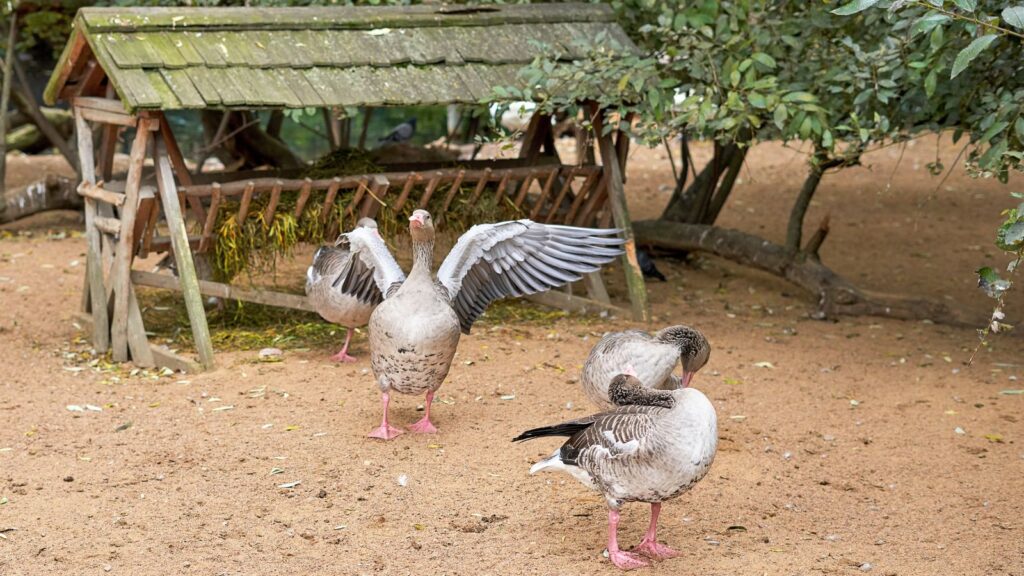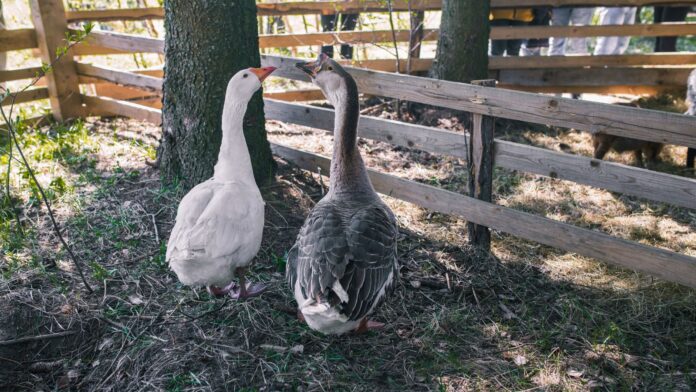Are you considering raising your own poultry for a sustainable and delicious source of meat? Look no further! Raising geese for meat is an excellent choice, offering numerous benefits such as rich flavor, nutritional value, and low maintenance care.
In this complete guide to homegrown poultry, we’ll cover everything from selecting the perfect breed to processing the final product in your backyard farm.
Key Takeaways
- Raising geese for meat is an easy and cost – effective way to produce your own protein in a sustainable manner.
- Geese are hardy animals that require minimal inputs and can be raised on pasture or backyard settings, making them an ideal option for off-grid living.
- Selecting the right breed of goose is crucial for successful meat production. Embden, Toulouse, and Chinese geese are popular breeds known for their fast growth rate and high-quality meat.
- Proper care and management of your flock’s housing conditions, feeding requirements, health concerns, exercise needs along with socialization are important factors towards healthy growth promotion while ensuring higher quality harvests.
Why Raise Geese For Meat?
Raising geese for meat is a great choice due to their nutritional benefits, ease of care and raising, cost-effectiveness, and environmentally friendly nature.
Nutritional Benefits
One of the key reasons to consider raising geese for meat is the nutritional benefits it offers. Goose meat, often described as rich and juicy without being greasy when cooked properly, is packed with essential nutrients like protein, iron, zinc, and B vitamins.
Moreover, since you’re raising your geese at home on limited pasture space and providing them with a natural diet devoid of growth hormones and antibiotics commonly found in commercially raised poultry, you’ll know exactly what goes into your food source – ensuring that you are consuming clean and wholesome meat.
Easy To Raise And Care For
Geese are incredibly easy to raise and care for, making them a great choice for those looking to raise their own meat at home. They require minimal inputs when compared to other livestock, and can be raised in small flocks or even in a backyard setting.
In addition to being low-maintenance animals, geese are hardy and can withstand harsh weather conditions without much assistance from their caretakers. Unlike chickens who require daily collection of eggs and cleaning of coops, geese only need occasional attention from their owners.
Environmentally Friendly
Raising geese for meat is not only a cost-effective way to produce your own protein, but it’s also an environmentally friendly option. Unlike industrial farming operations that rely heavily on synthetic fertilizers and pesticides, raising geese can help promote healthy soil and even benefit neighboring crops.
Geese are natural grazers and will happily eat weeds and other vegetation that would otherwise require expensive fuel or harmful chemicals to control.
In addition to being eco-friendly in the field, raising geese requires very little energy or water inputs when compared to other livestock like pigs or cows. This means you’ll have a smaller carbon footprint while still enjoying delicious homegrown meat.
And since most backyard flocks of geese are raised on pasture instead of in crowded feedlots, there’s less risk of contaminating nearby water sources with animal waste runoff.
Cost-Effective
Raising geese for meat can be a cost-effective way to produce your own protein on a small scale. Geese require little inputs and are efficient grazers, making them ideal for sustaining themselves on limited pasture space.
Compared to other livestock such as cows or pigs, geese have lower feed requirements and can subsist on grasses and grains found in your local area. Additionally, geese have few health issues when raised properly, reducing the need for costly veterinary care.
Selecting The Right Breeds For Meat Production
When choosing a breed for meat production, it is important to consider factors such as growth rate, feed efficiency, and temperament. Check out our guide on recommended breeds for meat production to make the right choice for your homegrown poultry needs.
Popular Meat Breeds
Some of the most popular breeds for meat production include Embden, Toulouse, and Chinese geese. Embden geese are a great choice for those who want a larger bird with a high meat-to-bone ratio.
They are also hardy and easy to care for, making them ideal for beginner poultry farmers. Toulouse geese are known for their flavorful meat and large size, while Chinese geese have tender meat that is highly sought after by gourmets.
Factors To Consider When Choosing A Breed
Choosing the right breed of geese for meat production can be crucial to your success. There are several factors to consider when choosing a breed, such as size, temperament, and overall hardiness.
For example, Embden geese are popular meat birds due to their large size and fast growth rate. However, Toulouse geese are known for their flavorful meat and calm disposition.
Additionally, if you live in a colder climate, you might want to choose a breed like the Pilgrim goose that is better adapted to thrive in those conditions.
Recommended Breeds For Meat Production
When it comes to raising geese for meat, selecting the right breed is crucial. Some popular breeds for meat production include Embden, Toulouse, and White Chinese geese. These breeds are known for their fast growth rate and high-quality meat.
For those living in colder regions with harsh winters, Brecon Buff geese are a hardy breed that can withstand extreme temperatures. Meanwhile, American Buff geese are excellent grazers that thrive on pasture-based diets making them a great choice for homesteads with access to ample grass or those looking to avoid commercial feeds.
Housing And Care For Meat-Producing Geese
To ensure the health and wellbeing of your meat-producing geese, it’s crucial to set up proper housing conditions, provide adequate feeding and watering, manage their overall health, and allow for exercise and socialization.
Setting Up The Right Housing Conditions
Geese are hardy birds and do not require a lot of shelter, but it is still important to set up the right housing conditions for them. A simple and cost-effective option is a small goose house or coop that provides adequate space for the flock to move around in comfortably.
The house should also have good ventilation to ensure proper air circulation, as geese can be susceptible to respiratory issues if kept in damp or stuffy environments. For outdoor access, consider setting up an enclosed area with fencing that will protect your geese from predators such as foxes or coyotes.
When designing your geese’s housing conditions, take into account their natural behavior and instincts. Geese enjoy bathing in water frequently, so including a shallow pool or basin within their enclosure will keep them happy and healthy.
Additionally, providing plenty of fresh straw bedding inside the coop can help keep them warm during cooler seasons while being easy to clean up regularly.
Feeding And Watering Requirements
Geese are easy to feed and require simple diets. They mainly eat grass, weeds, and grains. When raising geese for meat, it is important to provide them with a balanced diet that includes high-quality protein sources such as soybeans or fish meal.
Additionally, geese need a constant supply of clean water for drinking and bathing.
One great aspect of raising geese for meat is that they can graze on pasture land for their food intake, reducing the need for costly inputs like feed. However, if you live in an area where pasture space is limited or not available at all, providing your flock with high-quality hay and grain can supplement their diet effectively.
Managing Flock Health

Taking care of the health of your geese is important to ensure their well-being and productivity. Regularly inspecting the flock for any signs of illness, injury or parasites can help you catch potential problems early on.
One way to maintain good health is through regular exercise and socialization. Allowing your geese ample space to move around and interact with each other promotes healthy growth and prevents boredom-related issues such as feather-picking.
Additionally, incorporating natural supplements like garlic into their diet can boost their immune systems naturally.
Exercise And Socialization
Geese are social animals that enjoy being around other geese and even chickens. To keep your meat-producing geese healthy and happy, it’s important to provide them with enough space to exercise and interact with each other.
A fenced-in area or pasture works great for this purpose. Geese love to graze on grass, weeds, and other vegetation so providing access to these natural food sources will also help them stay active.
Socializing your geese also plays an important role in promoting good behavior among the flock members. By spending time every day interacting with your birds, handling them gently, and talking softly to them can help make them more comfortable in your presence leading less stress during handling when it comes time for processing.
Breeding And Reproduction
Geese mate for life and are easy to breed in captivity. To successfully hatch goslings, it is important to select healthy breeding stock, provide the right incubation conditions with a temperature of 99-100 degrees Fahrenheit and a humidity level of 50-60%, and turn eggs regularly.
Understanding The Breeding Process
To raise your own geese for meat, it is essential to understand how the breeding process works. Geese are typically monogamous animals and mate for life, which means that you will need one gander (male) and one goose (female) to breed successfully.
The breeding season begins in late winter or early spring when the days start to get longer.
Once a pair has bonded, they will typically mate several times over a period of weeks. The female goose will lay an average of 20-30 eggs per year, usually in a single clutch during the spring months.
It’s important to note that not all breeds of geese produce offspring consistently or regularly; some may only lay eggs once every few years. Therefore, it is vital to select the appropriate breed if breeding for meat production is your primary goal.
Incubating And Hatching Eggs
Once you’ve selected your breeding geese and are ready to start incubating their eggs, there are a few things to keep in mind. Incubation typically takes about 28-32 days, and during that time, it’s important to maintain consistent temperature and humidity levels.
You can either use an incubator or a broody hen to hatch the eggs.Once the goslings have hatched, they’ll need plenty of warmth and care for their first few weeks of life.
An interesting fact is that geese eggs require slightly lower humidity than chicken eggs during incubation – around 55-65%, versus 70% for chickens. This difference in requirements makes sense when you consider that geese naturally lay their eggs on open ground rather than inside a nest like most birds do.
Caring For Goslings
When raising geese for meat, it’s essential to have good knowledge about caring for goslings. Goslings require a warm and safe environment away from predators. A brooder box or area with heat lamps is necessary to keep the young birds comfortable.
Ensure that their bedding stays dry, clean, and changed often as they grow quickly and produce lots of waste.
Proper handling and socialization are critical when raising geese so that they become comfortable around humans.
Raising goslings requires a lot of patience and diligence but is rewarding when your flock grows up healthy enough for meat production while also serving as great watch animals on your homestead farmstead!
Harvesting, Processing And Butchering
After raising geese for meat, it’s important to know when to harvest them and how to properly process and butcher the birds, which can be done using various methods depending on your preferences.
Knowing When To Harvest
To ensure the best quality meat, it’s important to know when to harvest your geese. Typically, geese are harvested at around 20-24 weeks old for optimal meat quality and flavor.
It’s also crucial to prepare the processing area beforehand by ensuring all necessary tools and equipment are available. Humane slaughter is recommended, followed by plucking and cleaning the bird thoroughly before butchering.
Proper handling and storage of the meat after harvest can help maintain its freshness for an extended period of time.
Preparing For Processing And Butchering
Once your geese have reached the desired weight, it’s time to prepare for processing and butchering. The first step is to ensure that you have all of the necessary equipment and supplies on hand, including a sharp knife or hatchet, a large pot for boiling water, and space to hang the birds while they drain.
One method of processing involves scalding the bird in boiling water before plucking feathers and removing organs. Another option is dry-plucking without scalding. Regardless of which method you choose, make sure that your workspace is clean and organized to avoid contamination.
After processing, store meat in cool temperatures until ready for consumption or freezing.
Humane And Ethical Considerations
Ensuring the humane treatment of geese throughout their lives is an important aspect of raising them for meat production. This includes providing adequate space, shelter, food, and water to meet their basic needs.
Additionally, it’s essential to handle geese in a manner that minimizes stress and discomfort during processing and butchering. Many homesteaders opt for humane methods of slaughter by using a killing cone or other techniques that minimize pain or distress.
It’s also crucial to consider ethical considerations such as sustainability when raising livestock; small-scale farming can contribute positively to environmental conservation while supplying nutrient-dense food to local communities on smaller scales.
Different Methods For Processing Geese
Once you have determined it’s time to harvest your geese, there are a few methods for processing them. The most common method is dry-plucking, which involves manually removing the feathers with a plucking machine or by hand.
Wet-plucking is another option, where the geese are scalded first and then processed through a machine. For those who prefer not to pluck their birds, skinning is an alternative but can be tricky to get right.
It’s important to note that humane treatment of your animals during processing is crucial. A sharp knife must be used when slaughtering the bird, as quick and clean kills reduce any stress placed on the animal.
Tips For Handling And Storing Meat
After processing your geese, it is important to handle and store the meat properly to ensure it stays fresh and safe for consumption. Always wash your hands thoroughly before handling any meat.
Keep the meat cold by storing it in a refrigerator or freezer until ready to use.
When packaging the meat, use airtight containers or plastic bags labeled with the date of processing to keep track of freshness. Additionally, consider vacuum-sealing the meat for an even longer shelf life.
It’s also important to use separate cutting boards and utensils when preparing raw poultry products like goose, to avoid cross-contamination with other food items in your kitchen.
Using Every Part Of The Goose
Utilize every part of the goose, including meat for delicious recipes and feathers and down for various purposes.
Ideas For Using Goose Meat In Recipes
There are countless delicious ways to prepare and enjoy goose meat, making it a versatile addition to any off grid kitchen. One classic recipe is roasted goose with crispy skin and tender meat, which pairs perfectly with savory herbs like rosemary or thyme.
Another popular option is braised goose, which involves cooking the meat low and slow in flavorful broth until it becomes fall-off-the-bone tender.
If you have leftover cooked goose meat after your meal, there are many creative ways to incorporate it into other recipes as well. For example, diced or shredded goose can be added to soups for an extra protein boost, while ground or minced meat makes tasty burgers or sausage patties.
Don’t forget about the bones either – they can be simmered for hours with vegetables and aromatics to create rich homemade stock that’s perfect for use in all kinds of dishes like stews and gravies.
Utilizing Feathers And Down For Various Purposes
Geese are not just a source of meat and eggs, but also provide feathers and down that can be utilized for various purposes. Feathers can be collected from geese during their molting season, which typically occurs in the late summer or early fall.
Furthermore, goose down is soft and lightweight making it an excellent insulator for bedding materials or jackets. The high-quality insulation provided by goose down cannot be matched by synthetic alternatives – perfect for those living off-grid in colder climates.
Conclusion
Raising geese for meat is a great way to become self-sufficient and have a sustainable source of protein right in your own backyard. With the right breed selection, housing and care, breeding and processing techniques, you can enjoy delicious goose meat that’s healthier than factory-farmed options.
Geese are easy to raise and require little inputs which make it a perfect choice for small-scale poultry farming.
FAQs:
1. What are some benefits of raising geese for meat at home?
Raising geese for meat can be a financially economical and sustainable choice for homegrown poultry as they require less feed than other birds, and their high-quality meat has fewer calories and fat content than chicken or beef.
2. How do I prepare my backyard for raising geese?
Creating a safe, healthy environment is critical when keeping geese in your backyard. This includes providing ample space, easy access to food and water, protection from predators such as foxes or coyotes, and ensuring clean bedding is used regularly.
3. What type of nutrition should I provide my geese?
A balanced diet consisting of grains such as corn or wheat alongside protein sources like soybean meal or alfalfa pellets will help ensure your goose flock remains healthy throughout the year. It’s also essential to provide clean drinking water at all times.
4. What do I need to know about processing my own goose meat?
Processing your own goose meat requires careful preparation, including slaughtering the bird humanely using sharp knives and properly sanitizing any equipment used during butchering processes.
It may also involve learning how to skin and pluck your birds efficiently while following proper sanitation guidelines before freezing or preserving them in other ways so that the product remains fresh until you’re ready to use it in meals later on!




